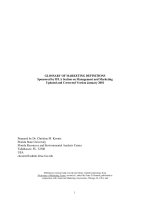Auditing markets products and marketing plans by david parmerlee
Bạn đang xem bản rút gọn của tài liệu. Xem và tải ngay bản đầy đủ của tài liệu tại đây (1 MB, 210 trang )
This page intentionally left blank.
Auditing Markets,
Products, and
Marketing Plans
A M A
M A R K E T I N G
T O O L B O X
David Parmerlee
NTC Business Books
NTC/Contemporary Publishing Group
abc
McGraw-Hill
Copyright © 2000 by The McGraw-Hill Companies. All rights reserved. Manufactured in the United
States of America. Except as permitted under the United States Copyright Act of 1976, no part of this
publication may be reproduced or distributed in any form or by any means, or stored in a database
or retrieval system, without the prior written permission of the publisher.
0-07-139203-3
The material in this eBook also appears in the print version of this title: 0-658-00133-7.
All trademarks are trademarks of their respective owners. Rather than put a trademark symbol after
every occurrence of a trademarked name, we use names in an editorial fashion only, and to the benefit
of the trademark owner, with no intention of infringement of the trademark. Where such designations
appear in this book, they have been printed with initial caps.
McGraw-Hill eBooks are available at special quantity discounts to use as premiums and sales promotions, or for use in corporate training programs. For more information, please contact George
Hoare, Special Sales, at or (212) 904-4069.
TERMS OF USE
This is a copyrighted work and The McGraw-Hill Companies, Inc. (“McGraw-Hill”) and its licensors
reserve all rights in and to the work. Use of this work is subject to these terms. Except as permitted
under the Copyright Act of 1976 and the right to store and retrieve one copy of the work, you may not
decompile, disassemble, reverse engineer, reproduce, modify, create derivative works based upon,
transmit, distribute, disseminate, sell, publish or sublicense the work or any part of it without
McGraw-Hill’s prior consent. You may use the work for your own noncommercial and personal use;
any other use of the work is strictly prohibited. Your right to use the work may be terminated if you
fail to comply with these terms.
THE WORK IS PROVIDED “AS IS”. McGRAW-HILL AND ITS LICENSORS MAKE NO GUARANTEES OR WARRANTIES AS TO THE ACCURACY, ADEQUACY OR COMPLETENESS OF
OR RESULTS TO BE OBTAINED FROM USING THE WORK, INCLUDING ANY INFORMATION THAT CAN BE ACCESSED THROUGH THE WORK VIA HYPERLINK OR OTHERWISE,
AND EXPRESSLY DISCLAIM ANY WARRANTY, EXPRESS OR IMPLIED, INCLUDING BUT
NOT LIMITED TO IMPLIED WARRANTIES OF MERCHANTABILITY OR FITNESS FOR A
PARTICULAR PURPOSE. McGraw-Hill and its licensors do not warrant or guarantee that the functions contained in the work will meet your requirements or that its operation will be uninterrupted or
error free. Neither McGraw-Hill nor its licensors shall be liable to you or anyone else for any inaccuracy, error or omission, regardless of cause, in the work or for any damages resulting therefrom.
McGraw-Hill has no responsibility for the content of any information accessed through the work.
Under no circumstances shall McGraw-Hill and/or its licensors be liable for any indirect, incidental,
special, punitive, consequential or similar damages that result from the use of or inability to use the
work, even if any of them has been advised of the possibility of such damages. This limitation of liability shall apply to any claim or cause whatsoever whether such claim or cause arises in contract, tort
or otherwise.
DOI: 10.1036/0071392033
Contents
Preface
v
Introduction
vii
Unit 1 Identifying the Primary Marketplace
1
Market Definition (by Industry Type)
Market Size Determination
Market Share and Penetration Measurement
Key Market Factor Assessment
Identification of Marketing Industry Standards
Identifying Secondary Target Markets
Customer Profiling
Competitor Analysis
Regulatory and Cultural Concerns
Additional Market Audit Applications
Comparing Your Market Audit Findings with Other
Published Data
Unit 2 Defining the Product Line Value
Product and Income Source Profiling
Product and Customer Management Review
Portfolio and Life Cycle Management
Sales Performance Evaluation
Analyzing Product Sales Patterns
Financial Profitability Measurement
Production Capacity Determination
Legal Concerns
1
19
22
24
29
35
36
50
59
62
63
65
65
66
69
79
83
87
91
95
McGraw-Hill's Terms of Use
New Product Thinking and Planning Analysis
Service Support Assessment
97
102
Unit 3 Evaluating the Effectiveness of Marketing
Actions
103
The Marketing Management Concept
Marketing Performance Measurement
Business Expansion and Growth Performance
Marketing Organizational Performance
Technology and Information Management
Marketing Strategy—Thinking and Planning Performance
Marketing Mix Performance
Marketing Implementation Success
Marketing Budget and Financial Impact Performance
Marketing Controls Performance
Unit 4 Preparing for the Analysis and Planning
Phases
Organizing the Audit Data
Preparing for the Analysis
Preparing for Strategic and Tactical Marketing Plans
103
104
110
111
118
121
122
173
180
185
189
189
190
192
Preface
Many marketing management books only define marketing and provide terminology definitions. The AMA Marketing Toolbox has a different purpose. This
series will guide you in analyzing and articulating marketing data and applying
it to real-world marketing actions. Definitions are included to form the basis for
effective marketing management. The narrative aspects of these books describe
the components of marketing processes. These books define the relationships
between the processes and explain how they all work together. They also supply sample formats to help you create sophisticated marketing documents from
your data.
A Systematic Process
Because markets change constantly and new marketing techniques appear all the
time, a step-by-step system is needed to ensure accuracy. The books are processbased to allow you to be as thorough as possible in your marketing activities and
document preparation. The books address marketing for the consumer package
product, business-to-business, industrial manufacturing, and service worlds.
For Marketers
Although these books are written with a how-to theme, they are written for
experienced marketers who know marketing terminology and understand the
business function of marketing. The AMA Marketing Toolbox series consists of
three books:
• Auditing Markets, Products, and Marketing Plans
• Developing Successful Marketing Strategies
• Preparing the Marketing Plan
v
vi
Auditing Markets, Products, and Marketing Plans
Role of the Marketing Management Audit
How does the marketing management audit you will perform fit in with the other
marketing processes? The marketing management audit is the first step in this
series. It identifies the market in which you are or will be marketing your products, defines the products you are or will be marketing, and evaluates the effectiveness of the marketing actions you are or will be employing. It determines
what, why, how, when, and where events and activities have or will be happening. This marketing tool helps you assess your strategic direction and how
you will program your annual marketing plan actions.
The books in the AMA Marketing Toolbox series will help you evaluate the
markets and the customers you serve, the products you offer, and methods in
which those products are marketed. The following diagram indicates where the
books fit into this process.
Research
Data Sources:
Primary
Secondary
Database
Internal
Analysis
Auditing Markets, Products,
and Marketing Plans
Developing Successful
Marketing Strategies
Planning
Preparing the
Marketing Plan
Introduction
What Is Marketing Management?
When one poses this question to various business executives, their replies are
almost always broad or abstract. To underscore the various interpretations of
this subject, ask ten business executives to describe how marketing as a business function contributes to their company’s success and you will probably
receive ten different answers.
This situation exists because marketing suffers from an identity crisis like
no other business function. Accounting, manufacturing, or human resources, for
example, all are considered to be fairly well defined; marketing, on the other
hand, is not. The reasons for this situation are so numerous it would take
another book to explain them. Instead, this book addresses this facet of marketing management by defining the established standards.
To produce and implement a pure balanced marketing plan, marketing management must be practiced by the organization or customers it serves. As businesses struggle to define what marketing is, they also need to devote their
energies to defining how it should be organized around customers and products.
Changes in technology, a diverse global economy, and sophisticated customers
who are media savvy and demand more value are dictating that marketing management be a complete and strong aspect of a company’s business practices. The
marketing plan must reflect not only the plan for action in a given year, but also
an approach to marketing that is not just a glorified sales plan or media-buying
strategy. To survive and succeed in today’s marketing landscape, companies must
move from “power and control” to “empowerment and cooperation” of marketing individuals. New methods such as sales automation, integrated marketing, process-based marketing, or digital media access must be employed.
Marketing management is the management of the process of developing marketing thoughts. It is the ability to isolate, control, and program the function
and functions of marketing. If it were not for the function of marketing, the
capitalistic or free enterprise system would not exist as we know it. Thus, marketing is the activity that bridges the item of value for sale with the customer
who wants or needs that item.
vii
viii
Auditing Markets, Products, and Marketing Plans
How Does the Audit Process Fit into Marketing
Management?
It takes preparation to produce a marketing planning document (strategic or tactical) and to administer the actions and results profiled in that document. In the
world of marketing, preparation translates into gaining accurate and timely data
to make wise decisions.
A marketing audit, like an accounting audit, is an instrument to measure the
value, risks, and effectiveness of your marketing efforts. Although it is considered to be a separate animal from traditional primary and secondary research,
it augments those data collection efforts by focusing internally on recorded performances and on past and present views of the future.
How Often Should a Marketing Audit Be Performed?
The frequency and the degree of detail needed to generate the appropriate marketing information will vary. Some companies will perform a complete audit
every year. Others will conduct an audit every four years, with modified versions used in between. Depending on the complexity of a given industry and
the amount of growth or change it is experiencing, the timing of a marketing
audit will differ. The key is to perform a complete audit (to form a solid baseline) in establishing your marketing approach, and then update that information as you feel it is warranted.
The Marketing Management Audit
How Does a Marketing Management Audit Work?
A marketing management audit consists of reviewing three fundamental elements:
• how you view and approach the markets you serve
• the value of the products you offer
• the effectiveness of the actions used to market those products
These three elements form the basis of a marketing management audit and
the overall structure of this book. The following sections in the Introduction
will explain how you can use the marketing audit to uncover the information
you will need to shape your eventual marketing activities.
Introduction
ix
The Market Audit Element
A market audit is an attempt to define the structure of the environment in which
a company operates—the marketplace. Its function is to collect information and
organize it in a fashion that alerts you to marketing needs, problems, and opportunities. This information becomes a document that provides a detailed, accurate, and unbiased view of the marketplace.
Why Perform a Market Audit?
The purpose of performing a market audit is to find out what to expect from
the marketplace you are currently in or are considering entering. It provides you
with data on any barriers or limitations you might encounter in entering or
expanding into a market so that you can determine what it will cost to exist or
compete. It also tells you what the possible return will be; in other words, what
the market is worth to you (market value) or what you can expect in terms of
revenue generation (sales volume/earning potential). The market audit is the base
from which you will develop strategies and tactics to achieve these returns.
A market audit builds the foundation for future marketing decisions. The
golden rule in performing a market audit is that you must be objective and read
the market as it actually is. This means the audit must not be structured around
your product, service, or business. Though these may be mentioned as reference
points, don’t make them central to the audit. To do so could result in conclusions slanted toward your business, giving you an inaccurate picture of the market and defeating the purpose of the exercise. The audit is based on market
research activities and must be completely independent from research on the performance of your product, service, or business.
The Product Audit Element
A product audit is an attempt to isolate and assess the worth of a particular thing
you sell to generate income. Its function is to collect and analyze data in an
accurate and unbiased manner to determine the value of your products to your
company.
The product audit gives you a clearer understanding of your product line
dynamics in a set format. It establishes why your products exist, how they contribute to the success of your company, and their impact on the marketplace. A
product audit has to answer the following questions:
• What needs do your products meet or what problems do they solve?
• How profitable are your products? Which are strong or weak?
• How many products can you produce now and in the future? Will that meet
demand?
x
Auditing Markets, Products, and Marketing Plans
• What possible legal actions do you face when marketing your products?
• What new products are you or should you be introducing?
Why Perform a Product Audit?
Like the market audit, the product audit tries to be as objective as possible: to
“read” your products’ value or purpose as it actually is, with little or no interpretation. The audit should mention the markets targeted with these products
or services only as reference points; to do otherwise could result in conclusions
slanted toward your product or business, thus giving you an inaccurate picture
of your product’s well-being and defeating the purpose of the exercise.
Think of a product audit as a player evaluation used to select a team to compete in a sporting event. Like a baseball manager, you have certain capabilities—
your product offerings—that you believe will allow you to compete and win
where the game is played—in the marketplace.
The chicken or the egg question—which comes first—always applies when
you are determining market impact versus product impact. In this example, we
are assuming that you will define and identify your market by performing a market audit prior to the product audit. The environment where you want to compete exists; you are now trying to determine how to select and use the players,
your products. To do this, you must assess your products individually and collectively to determine their strengths and weaknesses.
First evaluate your product capabilities—their features and benefits. Then
determine where they are in their life cycles. How many good years do they have
left? Concurrently, you need to examine each product’s contribution to the
“team’s” efforts. Some contribute more than others; this can be good or bad
depending on the individual product’s role.
Next you need to evaluate each product’s past and future sales performance.
If you have a “rookie player”—a new product—then you must predict its level
of performance based on current conditions. As you perform this exercise, try
to identify slumps and sales fluctuations to establish patterns. Then calculate
how profitable your products are. With each product, you have made an investment and, as with any financial risk, you are spending money in the hope of
making more money.
The next step is to determine production capacity for each product, the
“team’s” ability, its resources, and your liability for each product.
Finally, you need to determine what new products will be coming on board
through product acquisition and what products you have in the research and
development pipeline. How will new products help your product line?
Like a pro baseball team, your product line is the way you win, through
sales volume and revenues. To win the game, you must identify and cultivate
“players” who can perform consistently and produce a solid return for your
investment.
Introduction
xi
The Marketing Actions Element
A marketing actions audit is an attempt to evaluate the mechanism of the internal management of your marketing activities. Like its relatives, the market audit
and the product audit, the marketing actions audit collects and analyzes data to
arrive at results that are detailed, accurate, and unbiased.
The marketing actions audit gives you a clearer understanding of your marketing department in a set format. It assesses how effective you have been at
setting and achieving sales, revenue, market share, and profitability goals. It
examines your level of efficiency in marketing your products by the activities
you have used, the cost of marketing, and the control procedures used in your
marketing operations and organization.
As with the other two audits, you need to perform the marketing actions
audit as objectively as possible, examining how your marketing operations are
performed, with little or no interpretation. The audit should mention the market and products or services only as reference points; to do otherwise could result
in conclusions slanted toward your marketing actions, thus giving you an inaccurate picture of your marketing management and defeating the purpose of the
exercise. The market audit (where you will be marketing) and the product audit
(what you will be marketing) should have already been completed. The marketing actions audit (how you will be marketing your products to the market)
will link the market audit and the product audit together to give you a total picture of where you stand.
The Role of the Marketing Audit
The marketing audit tells a story about the marketing of your product offerings
to the marketplace. It explains what, why, how, when, and where events and
activities happen. The marketing audit tells you if your sales and revenue forecasting have been accurate and whether they have produced sufficient growth
to cover your costs and generate suitable financial earnings. It also measures how
you are approaching your marketing efforts. A marketing audit should be performed every three to five years on the average. If your products have a short
life span (e.g., high-tech products) and you are constantly introducing and terminating products, you should probably perform a marketing audit each year.
The marketing audit is the first section in a strategic marketing plan, which is
performed every three to five years, compared with a marketing plan, which is
performed every year. A marketing audit would not be appropriate for a new
business; a business plan would be a better alternative.
Reporting the Findings
Once the audits have been completed, you will need to document your findings.
In preparing your report for the next step (marketing analysis and planning),
be sure to include the following elements:
xii
Auditing Markets, Products, and Marketing Plans
• title page or cover page
• table of contents
• executive summary (purpose of the analysis and major findings)
• methodology
• limitations
• market analysis (body of report)
• exhibits
How Should This Book Be Used?
This book provides you with a set of audit formats to help you prepare a document that presents marketing research data in an organized manner. Throughout this book, you will be alerted to adjustments you may need to make in the
audit. To conserve space, each format shows a limited number of lines for products, whereas your firm may have fewer or many more products to consider.
Some formats call for sales of a product for the past three years, but if your
product is new, you will have no sales to date, making the current market share
analysis impossible.
The processes and formats in this book are designed for the consumer package product industry; however, when a specific issue requires a separate and clear
definition, other industries (industrial manufacturing/business-to-business and
service) will be profiled.
Exhibit 1 profiles how these three audits work together.
Exhibit 1
Audit Overview
Marketing Audit
Research Product Pricing Distribution Sales Advertising Promotions Public Legal
Marketing
Relations
Market
Audit
Product
Audit
Customer
The marketing management audit begins with the market audit and is followed by the product and marketing audits. Follow the first three units in the
book to reach completion.
Unit
1
Identifying the Primary
Marketplace
The first step in conducting a marketing management audit is to review the market in which your business operates. To accomplish this, you need to dissect the
elements that form the structure of a marketplace. This begins with the element
known as market definition, which entails interpreting how you view the types
of customers you are targeting. This effort establishes the foundation from which
you will assess the resources and thought processes needed to market your products successfully.
Market Definition (by Industry Type)
In defining your markets, you are putting a face on the market as it exists today.
This is the one place where you are afforded the opportunity to view the market in a subjective manner. This is because you need to decide on the size, complexity, and strength of a market you are willing and able to pursue. After this
exercise, every element that goes into forming each one of these markets will
need to be completed in a more objective manner.
You have two options to select from in defining a market:
• mass market
• markets divided into segments
Limiting yourself to selected market segments to gain more control in those
segments is usually most effective. Market segmentation begins with marketing
research. Before you can segment your market, you must understand customer
preferences, motivations, purchase intentions, and usage patterns to establish
linkages and verify the market profiles you select.
1
McGraw-Hill's Terms of Use
2
Auditing Markets, Products, and Marketing Plans
Depending on the industry you serve, market segmentation and variables that
are used to define customer attributes (characteristics) drive how you will determine which customers are available. Although other variables should be considered, such as customer profitability, customer status (new, current, or former),
and customer relationship (life cycle marketing), you may want to include these
variables as part of your market segmentation/target marketing efforts.
If you serve the consumer package product (CPP) or service industries,
Exhibit 1-1 illustrates the steps in selecting variables to define your market. In
these markets, you will use geographic, demographic/socioeconomic, product
usage, lifestyle/psychographic, synchrographics, shopping habits, and media
usage variables. Service industries vary greatly, so you may need to modify this
model.
Exhibit 1-1
Market Identification Model
Market ID
Mass Market
Segmented Market
Physical
Attribute
Variables
Behavioral
Attribute
Variables
Product
Usage
Synchrographics
Geographic
Demographic/
Socioeconomic
Lifestyle and
Psychographic
Shopping
Habits
Media
Usage
Profile of
Target Market
If you serve the industrial manufacturing or business-to-business (IMB)
industry, Exhibit 1-2 illustrates the steps in selecting variables to define your market. In this market, you will use geographic, demographic, product usage, and
media usage variables.
Unit 1: Identifying the Primary Marketplace
3
Exhibit 1-2
Market Identification Model
Market ID
Market Use
Pattern
Mass
Physical
Attribute
Variables
Behavioral
Attribute
Variables
Segmented
Geographic
Demographic
Product
Usage
Media
Usage
Target Market Profile
With both industry-specific models, you can select a type or combine several types of variables to form your market segment profiles.
Exhibit 1-3
Market Identification Process
1. Select market use patterns.
a. Mass (If selected, skip to “Market Size Determination,” page 19.)
b. Segmented
2. Identify segment markets.
a. Select variables.
b. Establish profile segments.
3. Define target markets.
a. Evaluate profile segments’ attractiveness.
b. Select/prioritize profile segments.
Once you select your markets, it is helpful to provide titles, or IDs, to each
market you have targeted—for example, the U.S. home consumer electronics
market. This will force you to truly define and establish (in terms of scope and
purpose) the market or markets you will be committing your product and marketing resources to capture.
4
Auditing Markets, Products, and Marketing Plans
Market Segmentation and Your Target Markets
Identifying your market segments is called target marketing. The secret is to find
a market where you can be a dominant player or at least a major player. To do
this, you must establish criteria to penetrate and compete effectively in those
target markets. The segmentation profile is made up of one or more physical or
behavioral variables that must be prioritized.
You may need to go through the market segmentation process several times
to determine which market definition works best for you. The key to the whole
process is the geographic location(s) of your market. As discussed, you must
perform market research before you begin the entire market audit process. That
research will help you identify, define, and analyze potential customers for your
product or for similar products in the selected market. The objective is to take
that research data and match it with variables in the segmentation process so
that you can see which geographic area has the highest number of potential
customers.
Geographic Variables
You will almost always need to set physical boundaries for your market. This is
done by selecting one geographic level or combining several, depending on your
particular market. Geographic variables should be determined separately for each
product line or individual product, if necessary.
To complete the table in Format 1, you must first select the level of the geographic area you choose to study. To give that level an identity, you need to call
it by name (i.e., Census Tract 7301.03). You should identify not only the level
you select, but several levels above it. This will give you a better point of reference and help you select the area(s) with which you wish to compare your target market. You will need to perform this audit for each product or product line
you are considering.
In the CPP or service industry, all geographic levels are available for market
definition. In the IMB industry, your geographic levels will be more limited
because customers are fewer in number and cover a larger geographic area.
Format 1 displays the geographic levels available. They are based on the geographic levels established by the U.S. Bureau of the Census. Many research and
database sources recognize these geographic levels as well as other “mediabased” (e.g., ADI, zip codes, etc.) geographic levels. You may want to include
these media-based levels as subgeographic levels so that you will have an equivalent basis of measurement when examining existing research data.
Demographic/Socioeconomic Variables
After you decide the physical area of your markets, you need to profile the possible customers in those areas. This is done by inserting the demographic/socioeconomic data (DSD) for those areas. With CPP and service industries, DSD
Unit 1: Identifying the Primary Marketplace
5
Format 1
Geographic Variables in Market Segmentation
Defined Area
Levels (Standard Unit)
Selection
Represents
Global/International
U.S.
National
Regional
Divisional
Illinois
State
Cook
County
Minor Civil Division/
Census County Division
(e.g., townships)
Chicago
Places (city and town)
Census Tract/Block
X
7301.03
Numbering Area
(population)
Block Group
Block
Street
Place of Residence/
Place of Business
addresses human beings. With the IMB industry, you are focusing on demographic variables that address businesses. In the IMB world, you rely primarily
on SIC (Standard Industry Classification) codes to define your customer type.
SIC codes have been used for many years to identify businesses, but the
federal government is in the process of replacing the SIC code system with NAICS
(North American Industry Classification System). This change is addressing the
need for more modern and detailed identification of businesses. The basic
framework is similar and provides the same type of information: defining a
business type at the lowest level and presenting statistical information linked to
individual business addresses and target market businesses. Government and
commercial syndicated data vendors are the sources of business data and coding
systems.
With the IMB industry, demographics tend to focus on size, industry behavior, and how a business operates (a business personality). The CPP and service
6
Auditing Markets, Products, and Marketing Plans
industries use demographic along with socioeconomic data to define customer
or household types by gender, age, martial status, education, occupation, ethnic origin, income, and housing patterns. In all industries, each company has its
own database full of variables and attributes that will be helpful in segmenting
the marketplace.
The key in market segmentation is to use it in a manner that allows you to
see how customers exist, based on the similar characteristics found. In other
words, you need to drop in the numbers of human elements that exist in those
areas. Each format provided in this section of Unit 1 is designed to produce
results based on the premise of that format. However, to really use market segmentation, you’ll need to cross-tabulate each format. That means you take, for
example, the geographic format and reference it to one or all other formats to
show the number of customers who buy a product (product usage), in volume
and frequency, by the various levels of geography. To accomplish this, you’ll need
to use a statistical or spreadsheet software package or the services and software
of a syndicated data vendor to produce the ultimate market segmentation results.
The first two variables used to convert the geographic numbers into population numbers are demographics (the who) and socioeconomics (the what).
These variables are based on U.S. Census Bureau counts of actual people and
households, rather than on statistical extractions that may not accurately reflect
the actual people and households in those areas. Census-based data is a more
reliable indicator of the basic structure of the population occupying the area
you are evaluating.
To complete Format 2-1, select the overall area or universe you wish to compare with the area you want to define. Remember, this is just an example—you
may want to include other headings in your format such as degree of penetration (%). Drop in the numbers you have obtained from various sources in the
columns for units, percentage, and index (which compares the two defined
areas).
Index represents a formula that gives you a benchmark to determine how
the two areas rank or rate. Interpretation may differ from vendor to vendor,
and your understanding may differ from the source that prepared the data. However, indexing in this environment is generally performed according to the following formula (using the demographic/socioeconomic variables shown in the
CPP industry):
Sex:
Male
Overall area percentage
divided by
Defined area
multiplied by
42.67
40.28 = 1.06 × 100 = 106
42.67
40.28
× 100
Unit 1: Identifying the Primary Marketplace
7
The number 100 gives you a baseline for comparison. If your defined market scores above 100, it has a higher propensity to accept your product. If it
scores below 100, it has a below-average propensity to accept your product.
The table provided in Format 1 can be used for CPP, service, and IMB
industries. For demographics and socioeconomic variables, the format tables will
be different. Format 2-1 addresses the CPP and service industries, and Format 2-2
addresses the IMB industry.
The ranges provided in Format 2-2 are only examples. The ranges and the
extent of the area you are segmenting may differ, based on your data needs and
the source of your data. Format 2-2 provides an example that is typically
available through syndicated data vendors. You can also perform this exercise
using your own customer information from your database. You can expand your
descriptors to include the following possibilities:
• types of customer service locations (e.g., rural, suburban, urban, etc.)
• sales performance patterns
• financial and operational risk
• key financial indicators (e.g., cost, sales, profitability, etc.)
• legal structure
• decision-maker identification
Product Usage Variables
After determining the physical area and the demographic data counts, you will
establish the customer’s behavioral attributes. Here you profile the various uses
for a product or service and determine the various levels of purchasing activity,
the factors that influence purchases, and the best methods of reaching those individuals regarding their purchasing decisions. To do this, you will select one or
more product usage variables.
You can use the table in Format 3 for all industries. Like all the formats provided, you can customize your tables to reflect the market data you need or the
information your data source provides.
In the CPP and service industries, many products offer similar features and
benefits to a similar market type. The objective here is to evaluate a product
with similar features to yours to determine how successful your product might
be in that same market. Your goal is to measure consumption of similar products and to rate them based on volume. You will need to perform this audit separately for each product line or individual product under consideration. For
example, if you sell toothpaste, you will want to compare your product with
another that is similar in name, packaging (pump or tube), form (gel, paste, or
powder), and flavor (mint or regular).
8
Auditing Markets, Products, and Marketing Plans
Format 2-1
Demographic/Socioeconomic Variables in Market Segmentation
State/Illinois
Defined Area (Target): Census Tract/7301.03
Overall Area (Universe):
Defined Area
Descriptor
Overall Area
Units
%
Units
%
Index (%)
Male
3,108
40.28
4,703,110
42.67
106.00
Female
4,637
59.72
6,320,197
57.33
96.00
7,745
100.00
11,023,307
100.00
Sex
Age distribution
2–5
6–11
12–15
(14–17)*
16–19
20–24
(18–24)*
25–34
35–44
45–49
(45–54)*
50–54
55–64
65–74
75 or older
*Note: variations in age breakdowns due to vendor variations.
Marital status
Married
Widowed
Divorced or separated
Single (never married)
Parent
Living together
Education (last grade attended)
Grade school or less (grades 1–8)
Some high school
Graduated high school
Some college (at least 1 year)
Graduated college
Graduate study
Full-time student
Part-time student
Unit 1: Identifying the Primary Marketplace
Format 2-1
9
(continued)
Demographic/Socioeconomic Variables in Market Segmentation
Defined Area
Descriptor
Units
Overall Area
%
Units
%
Index (%)
Occupation
Armed forces
Employed
Full time (More than 35 hours/week)
Part time (Less than 35 hours/week)
Hold more than one job
Self-employed
Unemployed (looking for work)
Occupation
Managerial
Professional
Technical
Administrative support
Sales
Operative/Non-farm laborers
Service workers
Private household workers
Farmers
Craftsmen
Other
Not employed
Student (full time)
Homemaker (not employed outside home)
Disabled temporarily
Retired
Ethnic classification
White
Black
Hispanic
Asian
American Indian
Other
continued
10
Auditing Markets, Products, and Marketing Plans
Format 2-1
(continued)
Demographic/Socioeconomic Variables in Market Segmentation
Defined Area
Descriptor
Annual household income
Under $10,000
$10,000–14,999
15,000–19,999
20,000–24,999
25,000–29,999
30,000–39,999
40,000–49,999
50,000–74,999
75,000–99,999
100,000+
Household producers
Full-time earner
Part-time earner
Dual earners
Size of household
(Age 18 or younger):
None
One
Two
Three or more
(Over age 18):
None
One
Two
Three or more
Householder status
Rent
Own
Live with parents
Type of housing unit
House
Apartment
Condo/townhouse
Mobile home
Other
Units
Overall Area
%
Units
%
Index (%)
Unit 1: Identifying the Primary Marketplace
Format 2-1
11
(continued)
Demographic/Socioeconomic Variables in Market Segmentation
Defined Area
Descriptor
Units
Overall Area
%
Units
%
Index (%)
Index (%)
Lived in area
Less than 1 year
1–2 years
3–4 years
5–10 years
11 or more years
Total
Format 2-2
Demographic Variables in Market Segmentation
Industrial Manufacturing/Business-to-Business Industries
State/Indiana
Defined Area (Target): Census Tract/4001.01
Overall Area (Universe):
Defined Area
Descriptor
Overall Area
Units
%
Units
%
26
100.00
334
100.00
8
6
5
6
1
26
30.77%
23.08%
19.23%
23.08%
3.85%
100.00%
80
89
120
40
5
334
23.95%
26.65%
35.93%
11.98%
1.50%
100.00%
77.84
115.47
186.83
51.90
38.92
7
8
6
4
1
26
26.92%
30.77%
23.08%
15.38%
3.85%
100.00%
90
79
110
50
5
334
26.95%
23.65%
32.93%
14.97%
1.50%
100.00%
100.09
76.87
142.71
97.31
38.92
SIC Code
632302
Annual Sales ($)
$100,000–$499,999
$500,000–$999,999
$1,000,000–$1,499,999
$1,500,000–$1,999,999
$2,000,000–
Employees
100–499
500–999
1,000–1,499
1,500–1,999
2,000–









